Chapter: Operations Research: An Introduction : Duality and Post-Optimal Analysis
Primal-Dual Relationships
PRIMAL-DUAL RELATIONSHIPS
Changes
made in the original LP model will change the elements of the current optimal
tableau, which in turn may affect the optimality and/or the feasibility of the
cur-rent solution. This section introduces a number of primal-dual
relationships that can be used to recompute the elements of the optimal simplex
tableau. These relationships will form the basis for the economic
interpretation of the LP model as well as for post-optimality analysis.
This
section starts with a brief review of matrices, a convenient tool for carrying
out the simplex tableau computations.
1. Review of Simple Matrix Operations
The
simplex tableau computations (row use only three elementary matrix operations:
vector) X (matrix), (matrix) x (column vector), and (scalar) X (matrix).These
operations are summarized here for convenience. First, we introduce some matrix
definitions:
1) A matrix, A, of size (m X n) is a rectangular array of elements with m rows and n columns.
2) A row vector, V, of size m is a (1 X m)
matrix.
3) A column vector, P, of size n is an (n xl) matrix.
These
definitions can be represented mathematically as

1. (Row vector X matrix, VA). The
operation is defined only if the size of the row vector V equals the number of rows of A. In this case,

2. (Matrix X column
vector, AP). The operation is defined only if the number of
columns of A equals the size of column vector
P. In this case,
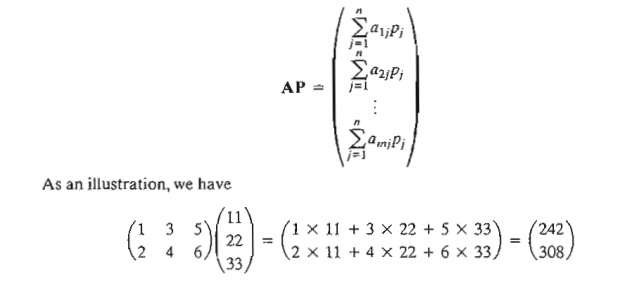
3. (Scalar X matrix, aA). Given the scalar (or constant)
quantity a, the multiplication
operation aA will result in a matrix
of the same size as A whose (i, j)th element equals aaij- For
example, given a = 10,

In
general, aA = Aa. The same operation is extended
equally to the multiplication of vectors by scalars. For example, aV = Va and aP = Pa.
PROBLEM
SET 4.2A
1. Consider
the following matrices:

In each
of the following cases, indicate whether the given matrix operation is
legitimate, and, if so, calculate the result.
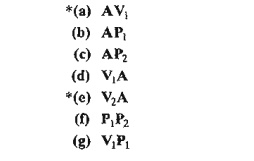
2. Simplex Tableau Layout
In
Chapter 3, we followed a specific format for setting up the simplex tableau.
This for-mat is the basis for the development in this chapter.
Figure
4.1 gives a schematic representation of the starting
and general simplex tableaus. In the
starting tableau, the constraint coefficients under the starting variables form
an identity matrix (all
main-diagonal elements equal 1 and all off-diagonal elements equal zero). With
this arrangement, subsequent iterations of the simplex tableau generated by the
Gauss-Jordan row operations (see Chapter 3) will modify the elements of the
identity matrix to produce what is known as the inverse matrix. As we will see in the remainder of this chapter,
the inverse matrix is key to computing all the elements of the associated
simplex tableau.

PROBLEM
SET 4.2B
1. Consider
the optimal tableau of Example 3.3-1.
*(a)
Identify the optimal inverse matrix.
(b) Show
that the right-hand side equals the inverse multiplied by the original
right-hand side vector of the original constraints.
2. Repeat
Problem 1 for the last tableau of Example 3.4-1.
3. Optimal Dual Solution
The
primal and dual solutions are so closely related that the optimal solution of
either problem directly yields (with little additional computation) the optimal
solution to the other. Thus, in an LP model in which the number of variables is
considerably smaller than the number of constraints, computational savings may
be realized by solving the dual, from which the primal solution is determined automatically.
This result follows because the amount of simplex computation depends largely
(though not totally) on the number of constraints (see Problem 2, Set 4.2c).
This
section provides two methods for determining the dual values. Note that the
dual of the dual is itself the primal, which means that the dual solution can
also be used to yield the optimal primal solution automatically.
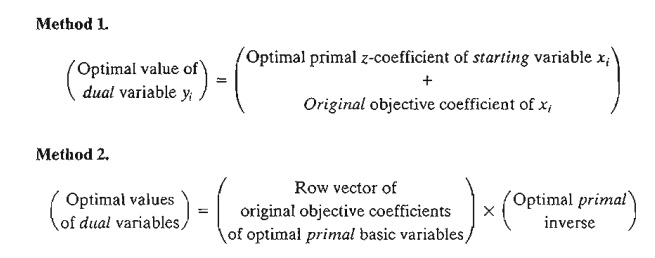
The
elements of the row vector must appear in the same order in which the basic
variables are listed in the Basic
column of the simplex tableau.
Example
4.2-1
Consider
the following LP:
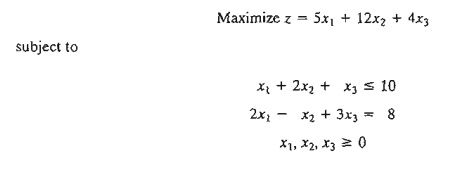
To prepare the problem for solution by the simplex method, we add a slack x4 in the first constraint and an artificial R in the second. The resulting primal and the associated dual problems are thus defined as follows:
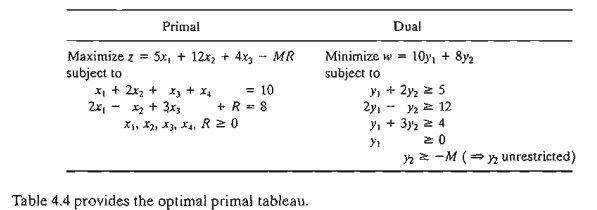
Table 4.4
provides the optimal primal tableau.
We now
show how the optimal dual values are determined using the two methods described
at the start of this section.
Method 1. In Table 4.4. the starting primal variables x4 and R uniquely correspond to the dual variables yl and y2, respectively. Thus, we
determine the optimum dual solution as follows:

Method 2. The optimal inverse matrix, highlighted under the starting
variables x4 and R, is given in Table 4.4
as

First, we
note that the optimal primal variables are listed in the tableau in row order as x2 and then x1. This
means that the elements of the original objective coefficients for the two
variables must appear in the same order-namely,
(Original
objective coefficients) = (Coefficient of x2, coefficient of xI)
= (12,5)
TABLE 4.4 Optimal Tableau of the Primal of Example 4.2-1
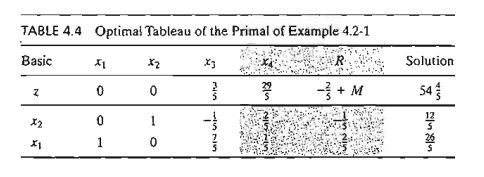
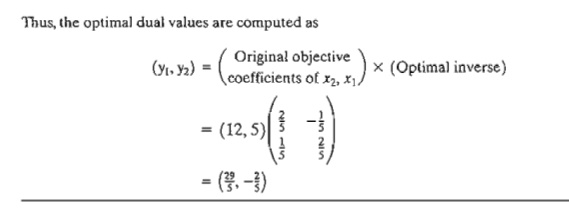
Primal-dual objective values. Having
shown how the optimal dual values are determined,
next we present the relationship between the primal and dual objective values.
For any pair ofjeasibLe primal and
dual solutions,

At the
optimum, the relationship holds as a strict equation. The relationship does not
specify which problem is primal and which is dual. Only the sense of
optimization (maximization or minimization) is important in this case.
The
optimum cannot occur with z strictly
less than w (i.e., z < w) because,
no matter how close z and ware, there
is always room for improvement, which contradicts optimality as Figure 4.2
demonstrates.
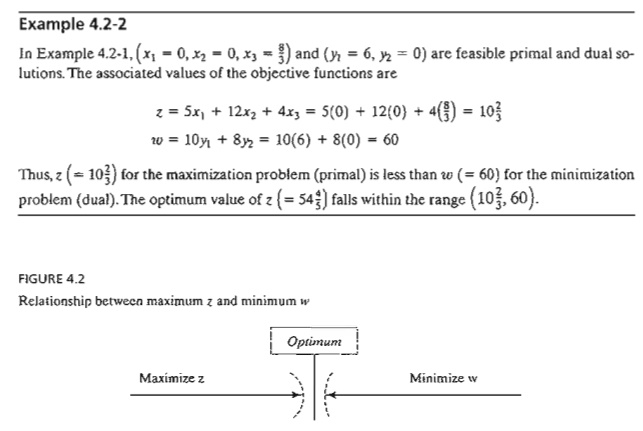
PROBLEM
SET 4.2C
1. Find
the optimal value of the objective function for the following problem by
inspecting only its dual. (Do not solve the dual by the simplex method.)

2. Solve
the dual of the following problem, then find its optimal solution from the
solution of the dual. Does the solution of the dual offer computational
advantages over solving the primal directly?
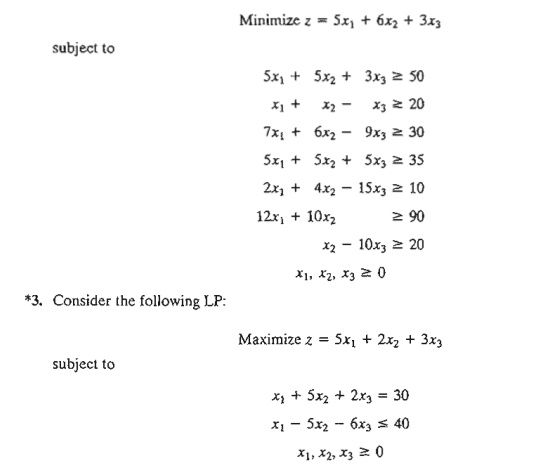
Given
that the artificial variable x4 and the slack variable x5 form the starting
basic variables and that M was set equal to 100 when solving the problem, the
optimal tableau is given as

Write the
associated dual problem and determine its optimal solution in two ways.
4. Consider the following LP:
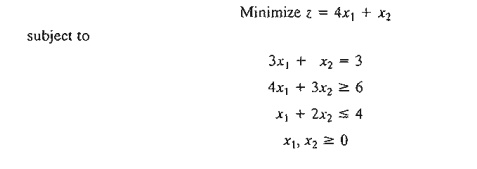
The
starting solution consists of artificial x4 and x5 for the first and second
constraints and slack x6 for the third constraint. Using M = 100 for the artificial variables,
the optimal tableau is given as

Write the
associated dual problem and determine its optimal solution in two ways.
5. Consider
the following LP:
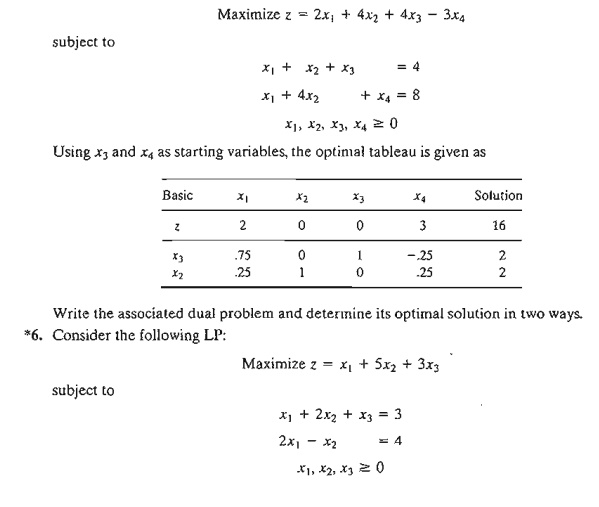
The
starting solution consists of x3 in the first constraint and an
artificial x4 in the second constraint with M = 100.
The optimal tableau is given as

Write the
associated dual problem and determine its optimal solution in two ways.
7. Consider
the following set of inequalities:
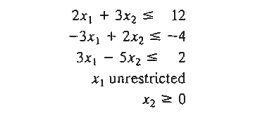
A
feasible solution can be found by augmenting the trivial objective function
Maximize z = x1 + x2 and then
solving the problem. Another way is to solve the dual; from which a
solution for the set of inequalities can be found. Apply the two methods.
8.
Estimate a range for the optimal objective value for the following LPs:
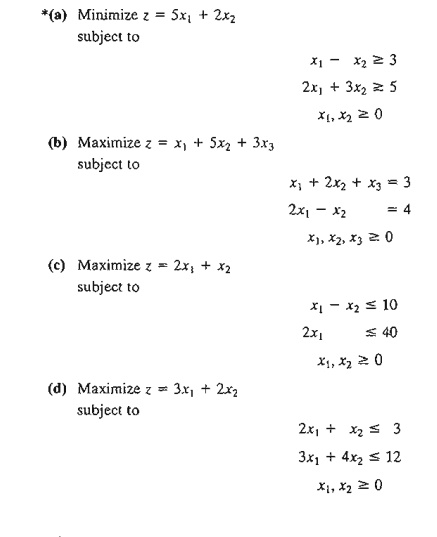
9. In
Problem 7(a), let yl and y2 be the dual variables. Determine
whether the following pairs of primal-dual solutions are optimal:

4. Simplex Tableau Computations
This
section shows how any iteration of
the entire simplex tableau can be generated from the original data of the problem, the inverse associated with the iteration, and the dual problem. Using
the layout of the simplex tableau in Figure 4.1, we can divide the computations
into two types:
a. Constraint
columns (Ieft- and right-hand sides).
b. Objective
z-row.
Formula 1: Constraint Column Computations. In any
simplex iteration, a left-hand or a right-hand side column is computed as
follows:

Formula 2: Objective z-row Computations. In any
simplex iteration, the objective equation coefficient (reduced cost) of xj is computed as follows:

Example 4.2-3
We use
the LP in Example 4.2-1 to illustrate the application of Formulas 1 and 2. From
the optimal tableau in Table 4.4, we have
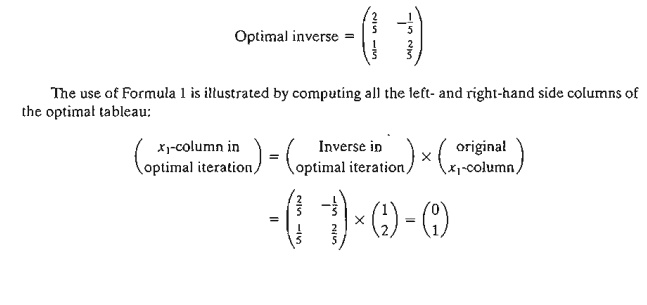

Next, we
demonstrate how the objective row computations are carried out using Formula 2.
The optimal values of the dual variables, (y1.
y2) = (29/5,-2/5), were computed in Example 4.2-1
using two different methods. These values are used in Formula 2 to determine
the associated z-coefficients; namely,

Notice
that Formula 1 and Formula 2 calculations can be applied at any iteration of
either the primal or the dual problems. All we need is the inverse associated
with the (primal or dual) iteration and the original LP data.
PROBLEM
SET 4.20
1. Generate
the first simplex iteration of Example 4.2-1 (you may use TORA's Iterations => M-method for convenience), then
use Formulas 1 and 2 to verify all the elements of the resulting tableau.
2. Consider
the following LP model:
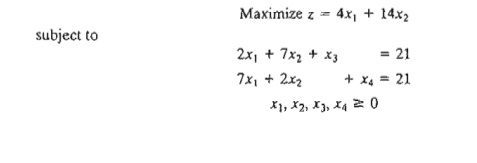
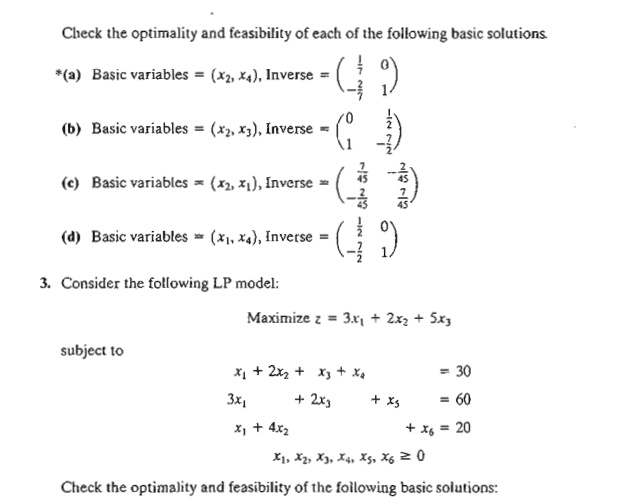

Compute
the entire simplex tableau associated with the following basic solution and
check it for optimality and feasibility.

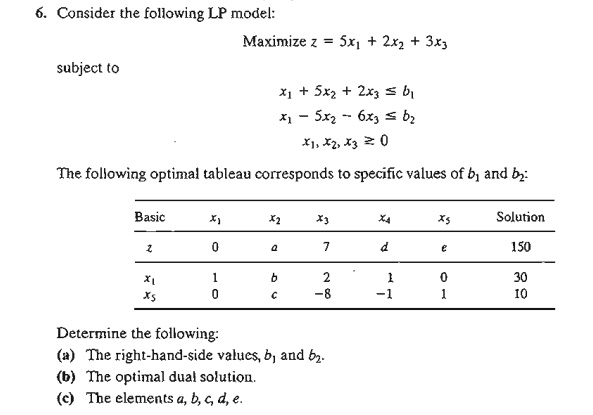
*7. The
following is the optimal tableau for a maximization LP model with three (≤) constraints
and all nonnegative variables. The variables x3, x4, and xs are the
slacks associated with the three constraints. Determine the associated optimal
objective value in two different ways by using the primal and dual objective functions.
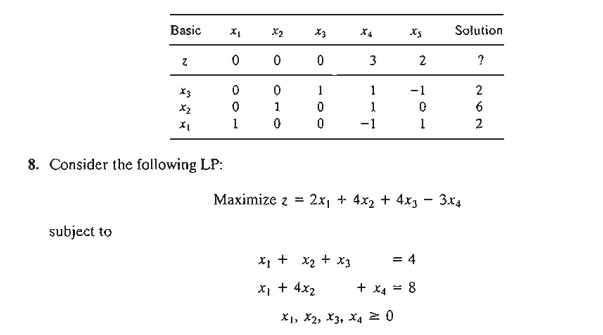
Use the
dual problem to show that the basic solution (x1, x2) is not optimal.
9. Show
that Method 1 in Section 4.2.3 for determining the optimal dual values is
actually based on the Formula 2 in Section 4.2.4.
Related Topics